
Bitcoin mining is the process of using computational power and energy to add new blocks to the Bitcoin blockchain. Miners that successfully add new blocks to the chain are rewarded for their contributions by receiving newly created BTC and transaction fees.
Bitcoin mining is the process of using computational power and energy to add new blocks to the Bitcoin blockchain. Miners that successfully add new blocks to the chain are rewarded for their contributions by receiving newly created BTC and transaction fees.
Bitcoin mining is similar to the production of other commodities: oil, gold, wheat, corn, etc., in that producers can profit by producing the commodity for less than the open market price. However, BTC differs wildly from the aforementioned commodities in that there is an absolutely limited supply. Due to bi-weekly difficulty adjustments, an increase in computational power dedicated towards Bitcoin mining will not result in the 21,000,000 BTC getting mined any faster than the predetermined rate (blocks every 10 minutes on average).
Bitcoin mining is a highly lucrative and competitive market. In 2023, the total hashrate of the Bitcoin network increased by 114% as miners sought to earn a slice of the last ~1.5 million BTC left to be mined. Sourcing the lowest-cost energy and the most energy-efficient ASICs is the key to out-hashing the competition.
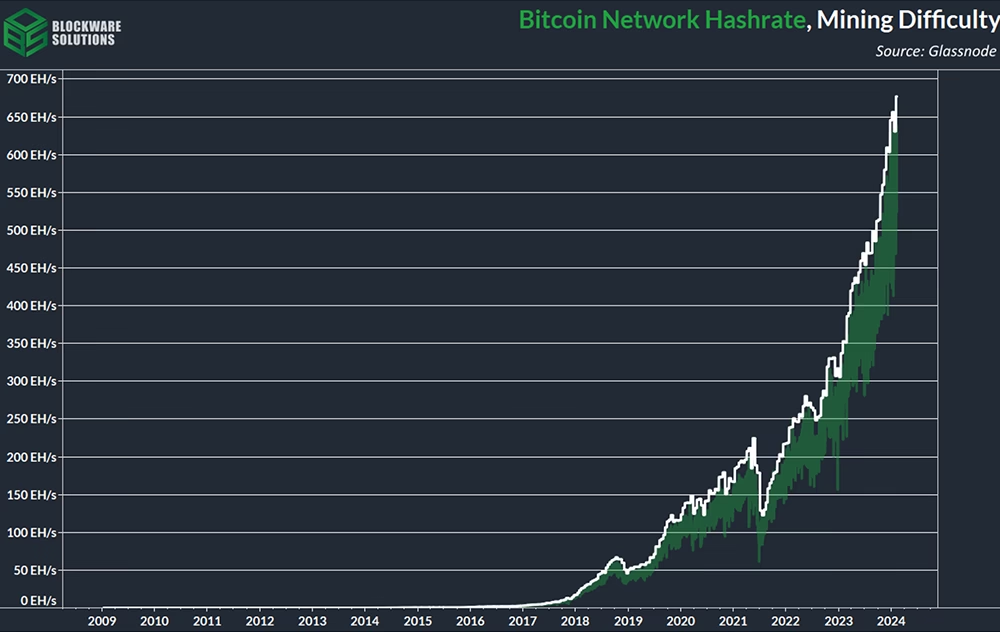
Like with most markets, timing is everything. Entering the Bitcoin mining market around the time of the halving was the winningest strategy during the previous cycle, and that is likely to be the case again this time around. The latest generation ASICs are fresh on the market, machines are at bear market prices, and BTC is on the cusp of its next bull market. The most successful miners are those that embrace the halving, rather than running away in fear.
The “Bitcoin Halving” event occurs every four years in which the newly issued BTC awarded to miners is cut in half. The first halving was in 2012, and they will continue to happen until the year 2140 at which point no new BTC will ever be created. The fourth halving event is projected to take place on April 20, 2024; and the amount of BTC mined daily will drop from ~900 to ~450.
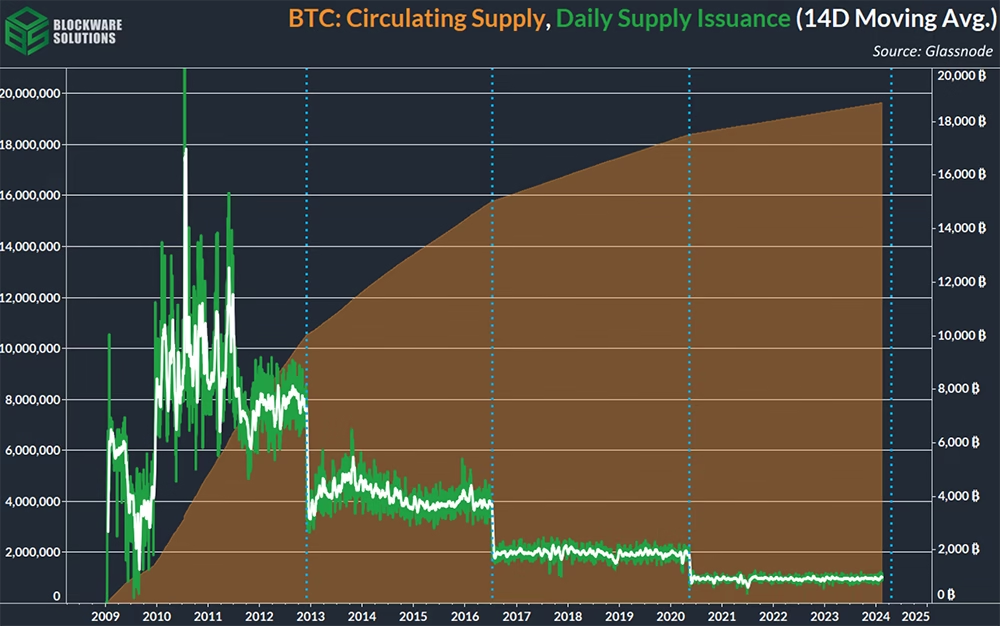
ASIC prices are highly correlated with the price of BTC. According to previous Blockware
Intelligence research, the price of Antminer S19s had a beta of 0.96 to the price of BTC during the 2021 bull cycle. For every 1% increase in the price of BTC, the price of S19s increased by 0.96%. In the twelve months following the 2020 halving, the price of BTC mooned from ~$9,000 to ~$60,000. Simultaneously, the price of S19s (the latest-generation ASIC at the time) went from ~$2,200 ($25/Th) to nearly $12,000 ($125/Th).
Minimizing your capital expenditure means you’ll earn a full ROI on the price of your ASICs much quicker than if you wait until the heat of the bull market, when machine prices are much higher, to start mining Bitcoin.
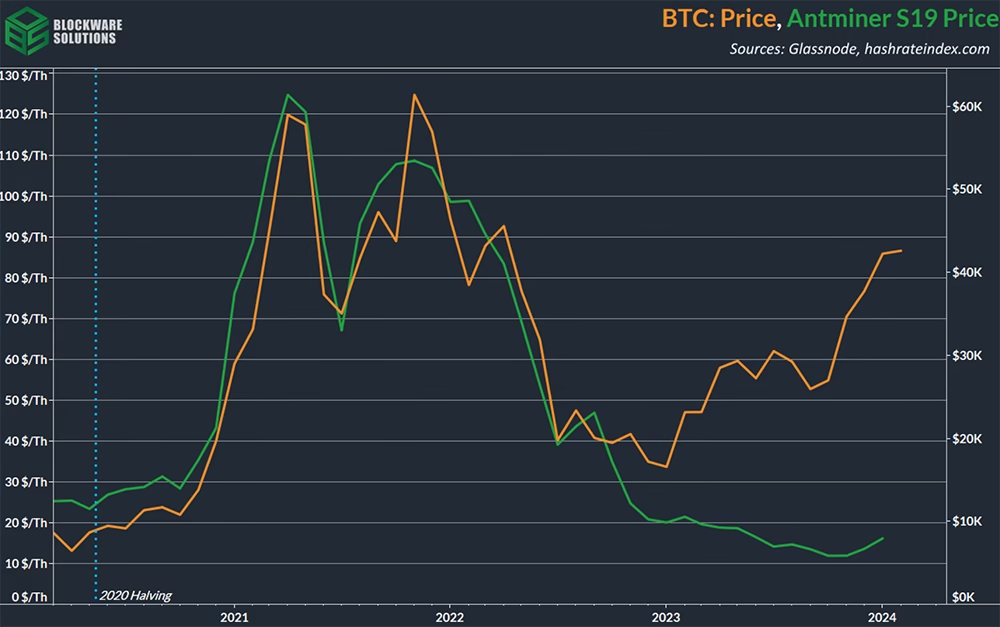
A perk of buying ASICs when they are cheap is that you’ll have unrealized gains on the machines. Prior to the creation of the Blockware Marketplace, realizing ASIC appreciation was a cumbersome process. The secondary market for ASICs was opaque and lived mostly in telegram channels. Miners integrated with the Blockware Marketplace can list machines for sale at any time and any price; granting them the option, but not obligation, to part with their machines before the end of their hosting contract. This completely changes the Bitcoin mining investment thesis as now there is a liquid market in which miners can sell their ASICs, allowing them to profit on their CapEx as well as profit from all of the BTC they mined while the machine was in their possession.
The Blockware Marketplace did not exist in 2021 when S19s reached $100+/Th. But if it did, having that access to liquidity on your ASICs during the bull market would have allowed miners to realize serious gains on their hardware alone, not to mention all of the profits they made mining Bitcoin. Now that the Blockware Marketplace exists, this is a viable strategy going forward with S21s. If you anticipate a Bitcoin bull market during 2024 and beyond, purchasing S21s through Blockware, and having access to liquidity via the Marketplace, will allow you to execute this strategy.
ASICs are single-use computers designed to do one thing only: mine BTC as efficiently as possible. The two metrics used to measure the performance of an ASIC are:
TH/s shows how much computational power an ASIC possesses. In other words, how much BTC can you expect this machine to mine; is a measure of revenue. W/Th is the measure of a machine’s energy efficiency. How much energy will this ASIC consume to produce X number of hashes; it is a measure of cost.
Each new-generation ASIC that hits the market is more powerful and more energy efficient than previous models. The Antminer S21 boasts 200 TH/s and 17.5 W/Th. Comparatively, the Antminer S19 is 95 TH/s & ~34.2 W/Th.
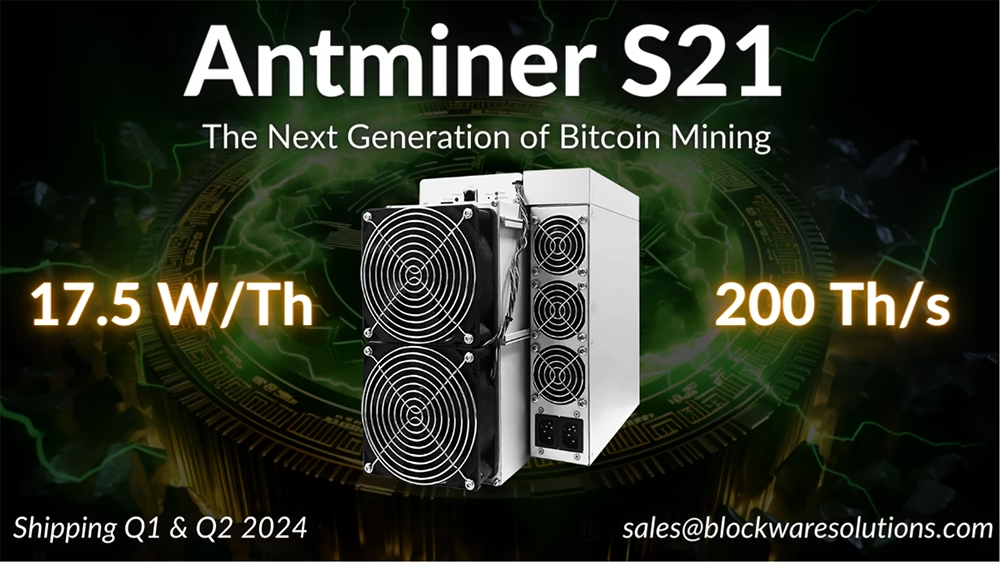
Mining with the best ASICs available on the market will ensure that you are managing risk appropriately. BTC is a highly volatile asset, and so is the profitability of Bitcoin mining. You can get away with using outdated hardware during bull markets. But around the time of the halving, mining profitability will take a major cut. Mining with the latest technology will put you in a position where other miners become unprofitable before you do, which will in turn cause them to unplug their machines, lowering mining difficulty, and allowing surviving miners to earn greater profits. Unless you have access to nearly free energy, your best bet is to get the most efficient machines possible. Which in 2024 are the Bitmain Antminer S21 and the MicroBT Whatsminer M60.
New-generation ASICs have an extended lifespan compared to older-generation models, increasing the window in which a miner can sell their machine and recoup their capital expenditure. This is true for two reasons. Firstly, the increased efficiency of new-generation ASICs means they are more profitable than older-generation models, making them capable of enduring the bear markets in which BTC has historically drawn down ~75% from its all-time
highs.
Secondly, ASICs are commoditizing. ASIC manufacturers are approaching the thermodynamic ceiling of energy efficiency. The marginal efficiency gains of each new-generation ASIC are diminishing. The S17 was 60% more efficient than its predecessor. The S19 was 27% more efficient than the S17. And now the S21 is 16% more efficient than the S19. The continuation of this trend means that the next generation to drop after the S21 (likely around the 2028 halving) will likely be less than 16% more efficient than the S21.
Diminishing marginal efficiency by gains means that modern-day ASICs will remain competitive for far longer than previous generations. Given this trend and the likely parabolic appreciation in the price of BTC during the coming years, S21s may remain viable through the 2028-2032 Bitcoin cycle.
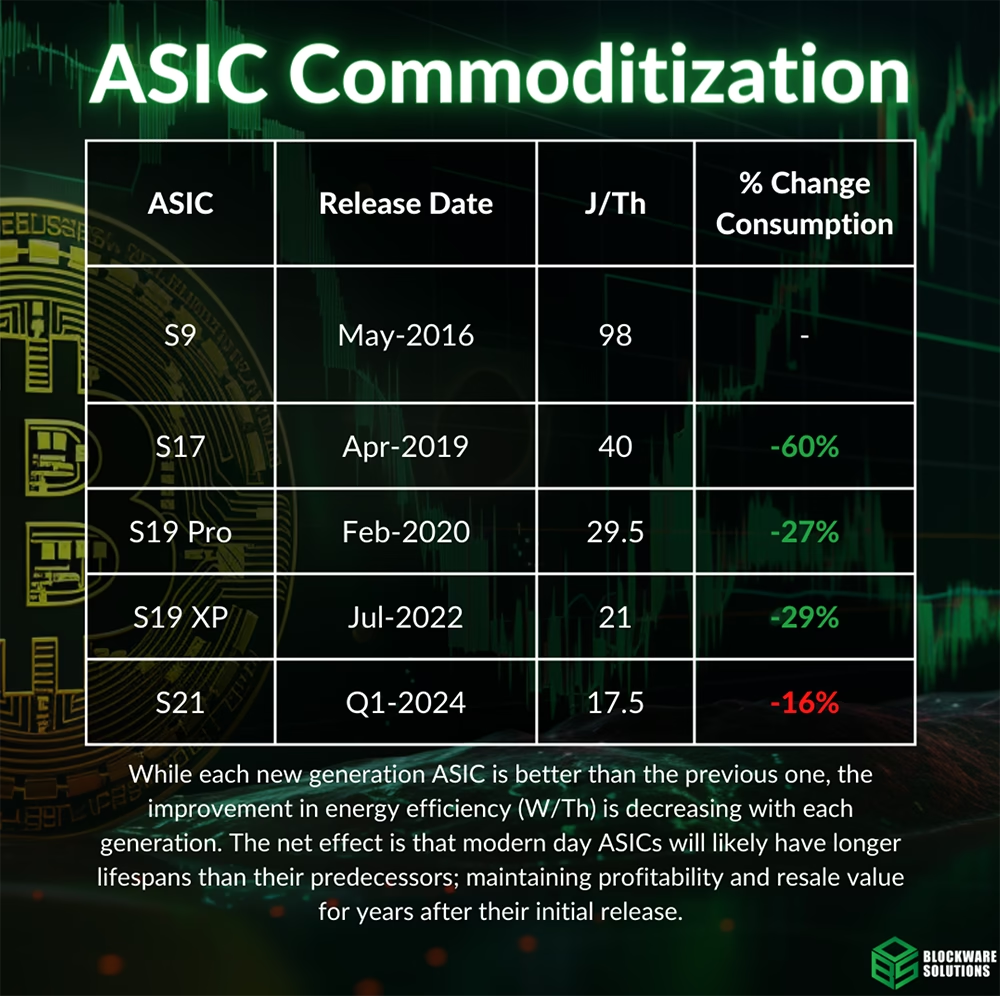
As the number 1 ASIC broker in the United States, we have experienced multiple Bitcoin cycles and have seen how demand changes throughout the various stages. During bull markets, everyone wants to mine Bitcoin. However, the most successful miners are the ones that start mining before the bull market.
“Be fearful when others are greedy, and greedy when others are fearful.” – Warren Buffet
Purchasing machines before the bull market, when everyone else is weary of the halving and BTC price action, is the best time to enter the market. First and foremost because hardware is cheaper. But an equally important reason is that buying machines now gives you time to get them online before the bull market begins. There’s a tremendous opportunity cost to being on the sidelines during bull markets. Having machines online ahead of time allows you to capture every second of the elevated mining profit margins.
Moreover, mining difficulty has a reflexive response to an increase in the BTC price. As the price of BTC rips, previously unprofitable ASICs (older-gen machines or miners with high electricity rates) begin plugging back in, causing a rise in difficulty. Furthermore, mining becomes a more attractive opportunity during bull markets, and new investments are made into ASICs and mining infrastructure. A few months after the peak of the bull market we have
historically seen a bull market in hashrate/mining difficulty (note the 114% hashrate growth in 2023.)
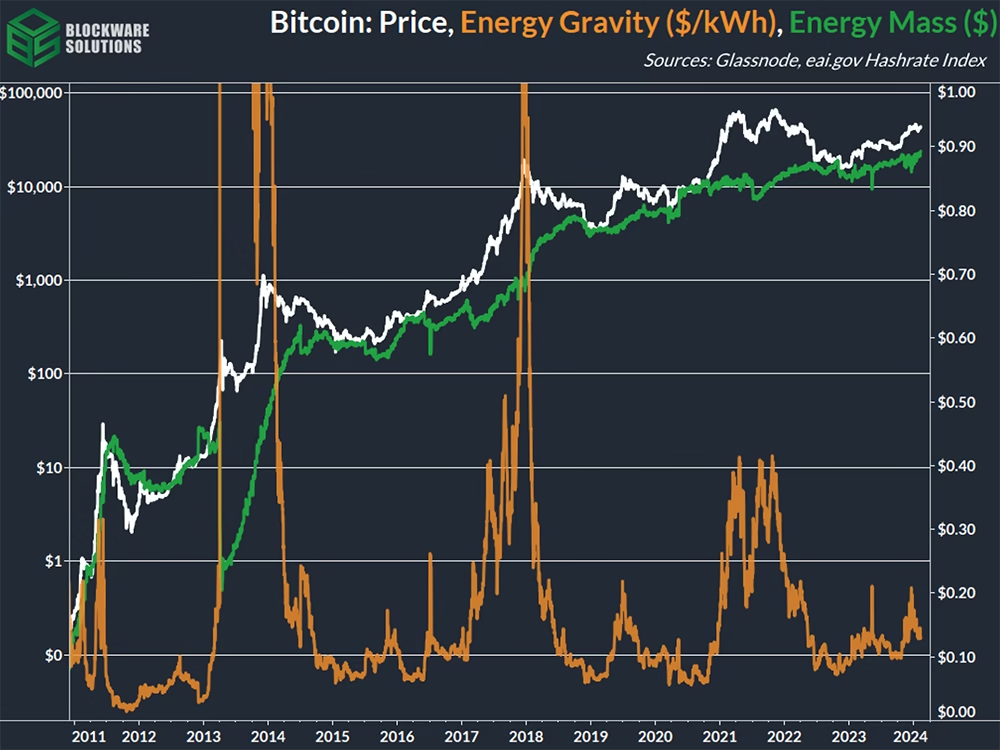
It’s no secret that Bitcoin is volatile. Bull markets send the price north violently fast, bringing with it an equally powerful feeling of exuberance. Bear markets are nasty, flushing out over-leveraged actors and uneducated market participants. There are a plethora of factors driving the cyclical price action of BTC: halvings, holding behavior, demand shocks, and global liquidity. In 2024, each of these winds is blowing in a direction that is sending us toward another parabolic bull run.
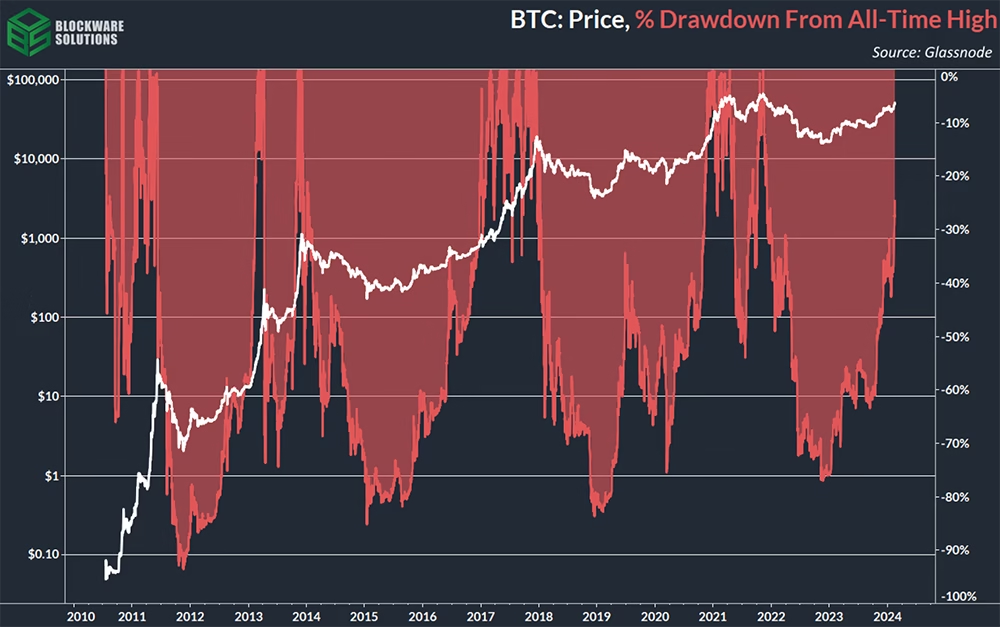
The ETFs are a demand shock, unlike anything before seen in BTC’s brief, 15-year existence. At the time of writing, cumulative daily inflows into the ETFs have eclipsed $500,000,000 (~10,000 BTC worth). Comparatively, this is more than 10x greater than the amount of new BTC entering circulation via mining daily; 900 BTC. After the halving in April, only 450 new BTC will be mined every day. Meaning that ETF flows will be 20x greater than
newly mined BTC.
Moreover, these products are still very nascent and it’s reasonable to assume that ETF flows should increase over time. Target BTC allocations for asset managers range anywhere from 1-5%. With current total flows hovering around ~$34 billion, there’s a way to go until the $14.5 Trillion combined AUM of Blackrock and Fidelity is fully deployed into BTC; which with a 1% allocation would represent ~$145 billion in inflows. This is a low-bar estimate of potential inflows that doesn’t even include institutional investors, private wealth managers, publicly traded corporations, and retail investors.

With ETFs representing an unprecedented level of demand, let’s examine the supply side of the equation. You’ve likely seen the “HODL Waves” chart before; this divides the circulating BTC supply into tranches based on how long since each coin last moved on-chain, providing a transparent view of holding behavior. ~79% of BTC’s supply hasn’t moved in at least six months, despite significant price appreciation during the same period.
Spikes in HODL waves have historically preceded Bitcoin bull markets as new demand meeting supply-side illiquidity forces a phase of exponential price discovery. The price of any asset is set at the margin. In other words, the only trade that matters for determining price is the next one. If all the BTC is held by market participants unwilling to sell at the current price, buyers must bid the price higher to incentivize sellers to part with coins.
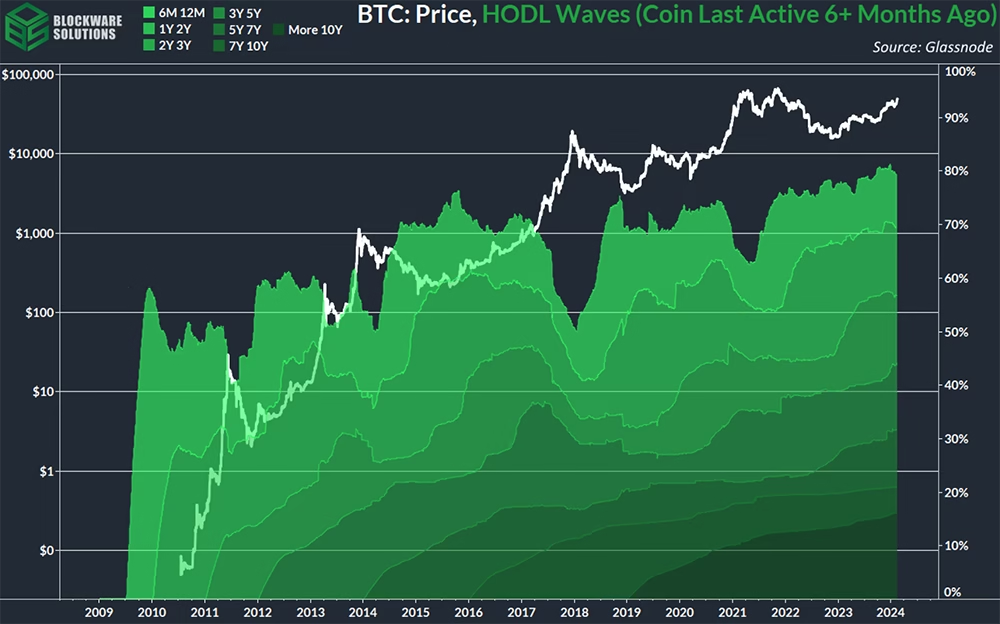
Bitcoin, as an open, public ledger, provides us with a transparent view of ETF flows and on-chain HODL’ing behavior. Macroeconomic factors are far more opaque and difficult to predict. Expectations about global liquidity, government deficit spending, and Fed policy are constantly evolving.
Fiat liquidity is the primary driver of asset prices, BTC included, as we measure prices with $ in the denominator (BTC / USD). Despite the rate-hiking crusade by the Fed, global liquidity increased 2.4% in 2023. Notice the tight correlation between BTC price action and global liquidity.
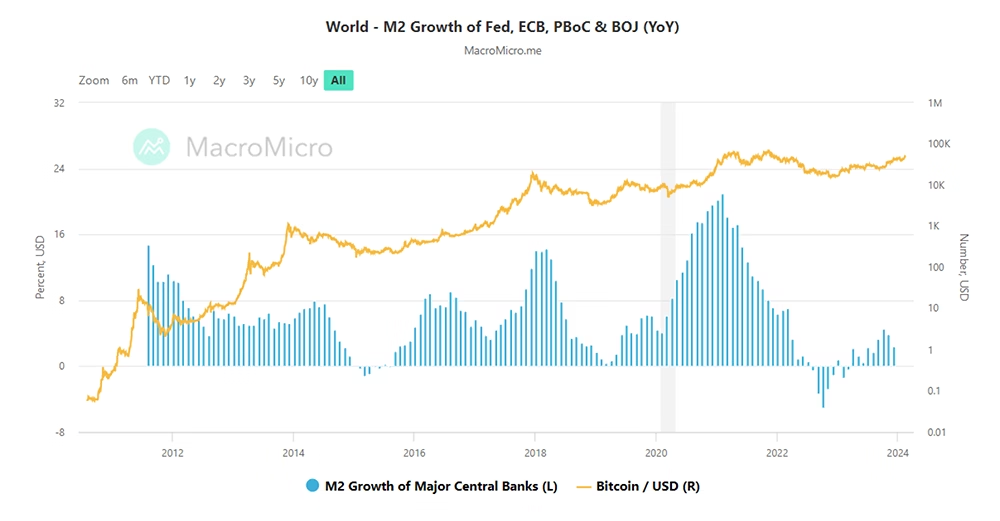
The big-picture macroeconomic story remains the mounting global debt burdens. US debt has eclipsed $34 trillion and debt-to-GDP sits at 120%. In a recent interview on 60 Minutes, Fed Chairman Jerome Powell confessed to the negative long-term consequences of US fiscal policy. He described the situation as “unsustainable”, and said that the United States is “borrowing from future generations.” Barring an unprecedented boom in domestic productivity, the only mathematical way for the US to service the growing debt in nominal terms is through monetary expansion.
Inject new units of currency into the economy → nominal GDP increases → nominal tax receipts increase → service debt.
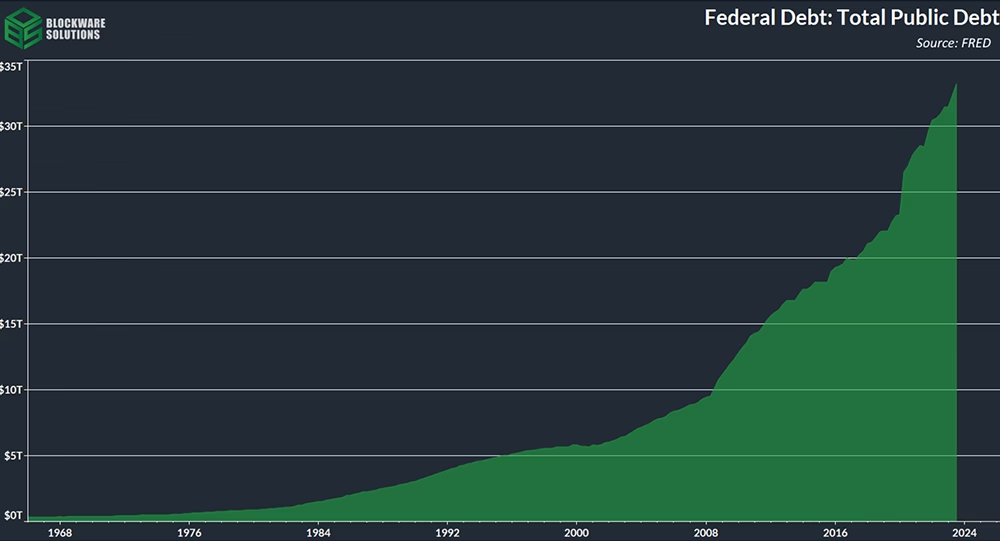
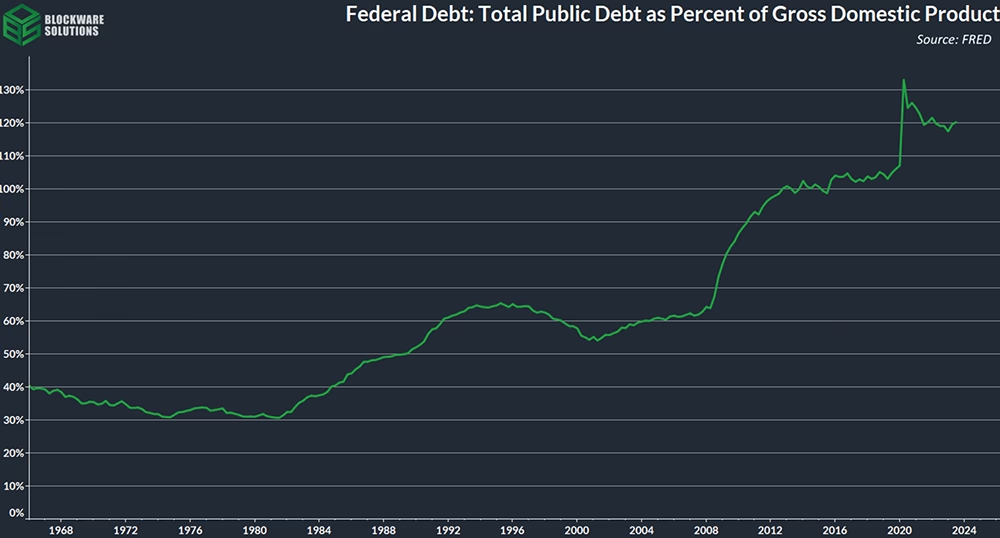
Monetary policy from the Fed & fiscal policy from Congress are pulling opposite directions; with the former having a net-negative effect on liquidity and the latter being net-positive. Annual deficit spending began declining after the pandemic, however spending has since reversed and the annual deficit is back north of $1.5 trillion.
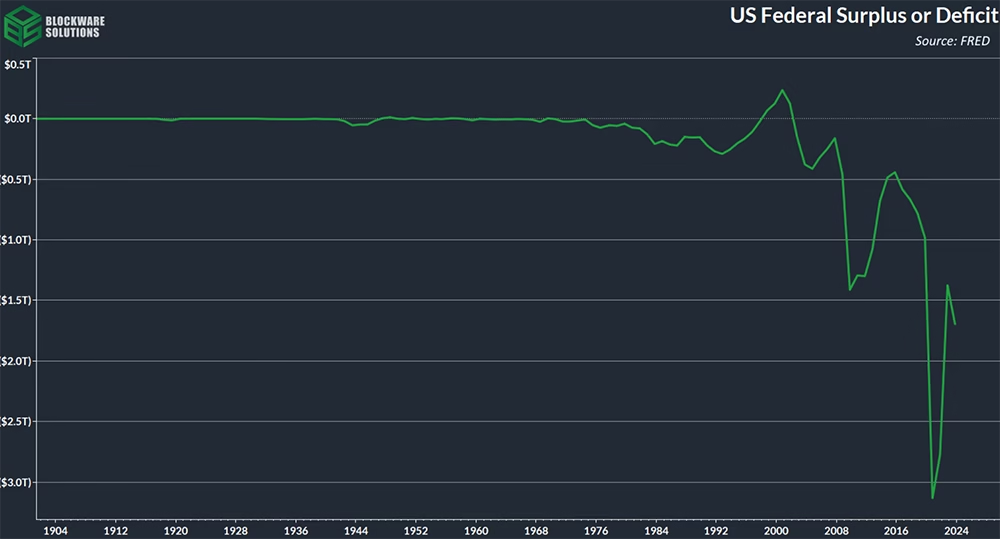
Alongside deficit spending, the Bank Term Funding Program (BTFP) has been a sneaky source of liquidity throughout the past year, with a total usage of around ~$160 billion. There has been a second wave of banks tapping into this facility as the Fed announced it will not continue past March of this year.
It remains to be seen how “sound and resilient” the banking system will be once this facility is discontinued. The Fed is making it a requirement for all banking institutions to borrow using the discount window. The objective is to remove the negative stigma associated with doing so, providing plausible deniability for potentially insolvent institutions (if everyone is required to use it then it’s difficult to tell which banks are having liquidity issues).
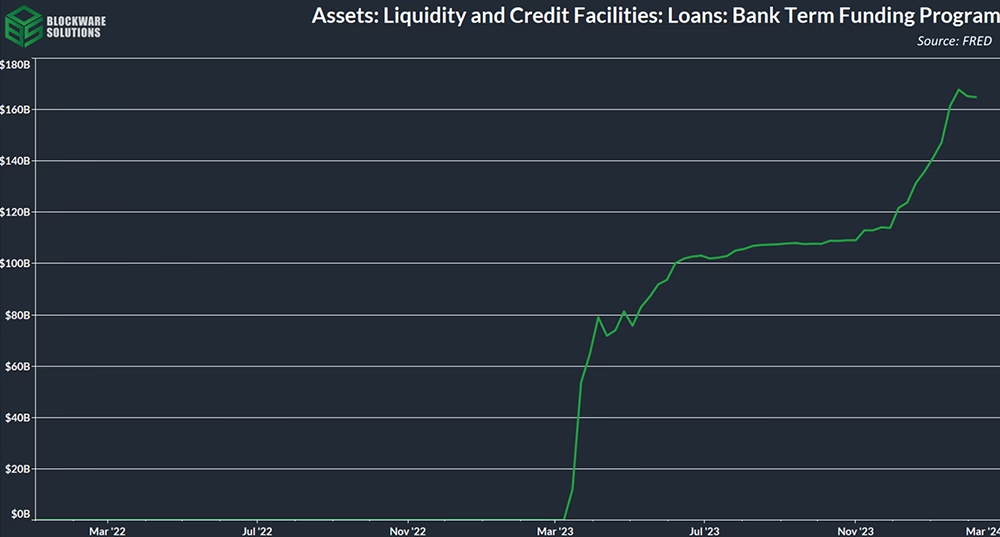
Based on the relationship between US treasury bond yields and the Effective Federal Funds Rate, the market expects the Fed to begin cutting sometime in the next 6-12 months. The 1-year note is yielding 4.95% while EFFR sits at ~5.33%. Before the recent CPI print came in above expectations, the 6-month yield was pricing in cuts.
With interest payments on the US debt more than $1 trillion annually, rate cuts are a matter of when not if. Recent treasury auctions have been tilted heavily towards short-term debt, to avoid locking in long-term debt at elevated rates.
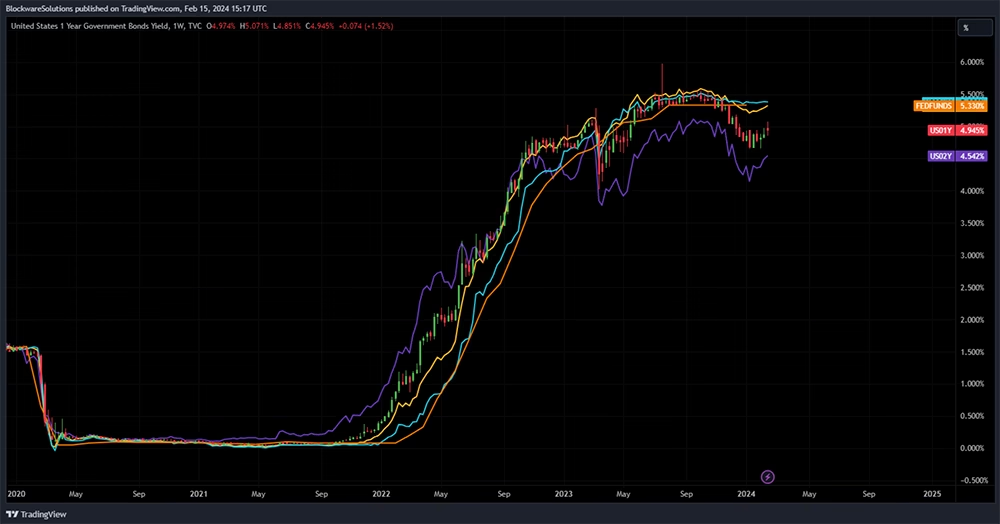
The strategy we detailed in this report – purchasing the latest-generation ASIC right before the halving – was extremely effective during the 2020/21 Bitcoin cycle.
Here are the assumptions for this case study:
Executing this strategy resulted in a complete ROI on the cost of the ASIC in just 291 days. To date, this miner HODLs ~0.379 BTC worth ~$18,300.
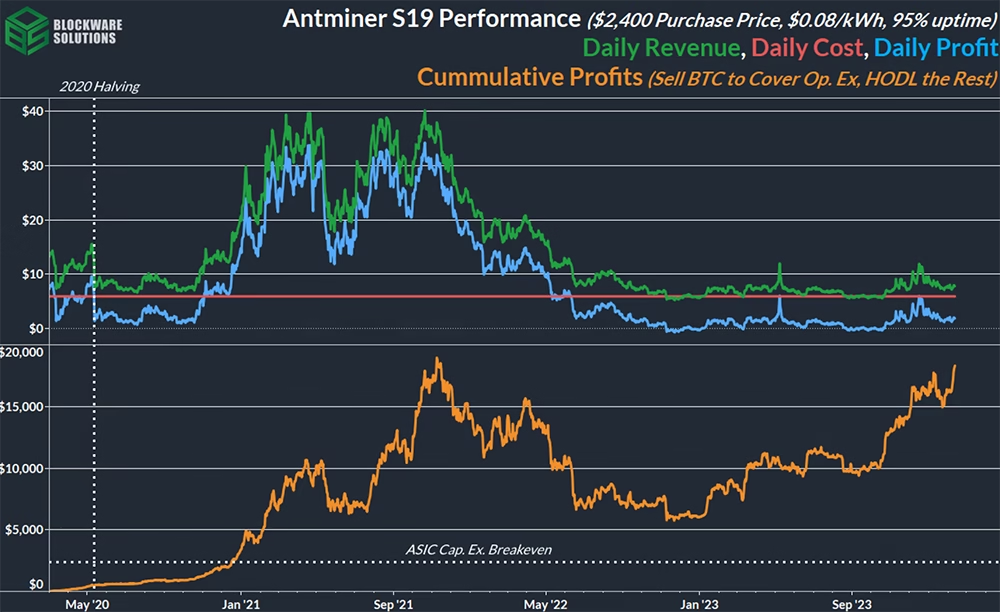
Here we can see the % change in price of an S19 throughout the past four years. At the bull market peak in 2021, an S19 was up nearly 400%. Hindsight is twenty-twenty, but buying ASICs before halving and selling them during the peak of the bear market was an incredibly profitable maneuver during the past cycle. S21s will likely provide this same opportunity going forward; even more so due to ASIC commoditization, and institutional capital potentially making this bull market more potent than the last.

In this report we underscored the importance of strategic timing and hardware selection in the Bitcoin mining industry. By entering the market before halving events and investing in the latest-generation ASICs, miners can position themselves for success in the ever-evolving landscape of Bitcoin mining. The data suggests that miners who embrace the halving and capitalize on bear market prices for hardware stand to reap substantial rewards, with shorter ROI periods and enhanced profitability throughout the halving epoch.
Furthermore, the bullish catalysts highlighted in the market analysis section provide additional support for a favorable outlook on Bitcoin mining. ETF inflows, illiquid supply dynamics, and macroeconomic trends indicate generally bullish BTC price action for the foreseeable future. Foresightful miners, who deploy capital now into the latest-generation ASICs, are poised to thrive throughout the 2024-2028 Bitcoin epoch.
All content isfor informational purposes only. This Blockware Intelligence Report is of general nature and does consider or address any individual circumstances and is not investment advice, norshould it be construed in any way astax, accounting, legal, business, financial or regulatory advice. You should seek independent legal and financial advice, including advice asto tax consequences, before making any investment decision.